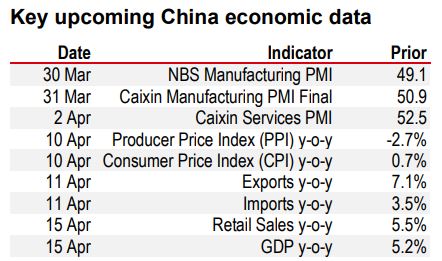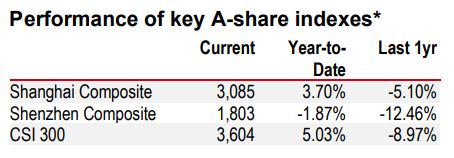
27 Mar 2024
China’s policymakers highlighted ambition to promote large-scale equipment upgrading, a market estimated to be worth cRMB5trn annually (c4% of GDP), along with maintaining a focus on recycling during the process. This could accelerate depreciation of existing equipment, thus stimulating replacement demand. Meanwhile, the government’s ‘AI+’ initiative aims to drive transformation of traditional industries, making AI platforms more accessible and affordable.
However, there are still challenges for the industrial sector, such as “excessively fierce” competition and overcapacity (NPC, 6 March). Even as the domestic recovery gathers strength, it is not yet back to pre-pandemic levels while global demand has been relatively weak. Noting the need to better balance the market and improve capital allocation, the People’s Bank of China (PBoC) Governor noted that funding to sectors facing overcapacity would be curbed.
Under China’s new housing development model, policymakers aim to “establish a linkage among people, housing, land, and finance, where people determine housing, housing determines land, and housing determines finance” (Xinhua, 9 Mar). Statements suggest that housing policies will be localised and closely aligned with demographic trends, leaving room for governments to relax private housing restrictions and convert excess supply into social housing.
Domestic consumption has continued to be a leading force for economic growth over the last year. Alongside the calls to boost equipment upgrading demand, the government will also launch a consumer upgrading initiative aimed at boosting sales of large durable consumer goods such as auto sales and household appliances. This can help to broaden out the still strong services consumption and in turn unlock more industrial production and manufacturing investment spending. China has also budgeted more spending on social welfare while looking to promote the urbanisation of 170 million migrant workers and their families yet to settle in cities, which involves granting them social security, housing benefits, and public education.
The Chinese Securities Regulatory Commission (CSRC) continued to emphasise the importance of capital market reforms and strengthened financial market supervision to better attract longterm investors. They said that they would encourage companies to use dividend payouts while also resolving to crack down on fraudulent disclosures and make improvements on delisting regulations, and merger and acquisition policies. This should help to revive investor sentiment, especially when economic fundamentals and corporate earnings improve.
The NPC a sent clear signal for more proactive policy stance. Fiscal policies will play the leading role, as manifested in the punchier broad fiscal deficit of 8.3%, a 1.3ppt fiscal impulse compared with last year’s 7.0% figure. Monetary policy will likely stay accommodative too, with further Reserve Requirement Ratio (RRR) and interest rate cuts on the table in 2024. The PBoC could also inject more liquidity via monetary policy tools such as Pledged Supplementary Lending (following the RMB500bn net injection in December 2023 and January 2024).
Issuance of ultra-long term special treasury bonds, starting with RMB1trn this year, is intended to hit multiple targets including: 1. boosting domestic demand, 2. optimising government debt structure, by shifting more spending responsibilities to the central government, and 3. building the foundation for structural transition, with funds will go towards “major national strategies and security capacity building”, according to the head of the National Development and Reform Commission said (NPC, 6 March).
The NPC a sent clear signal for more proactive policy stance. Fiscal policies will play the leading role, as manifested the punchier broad fiscal deficit. Compared with last year’s 7.0% figure, this means 1.3ppt fiscal impulse. Monetary policy will stay accommodative too, with another RRR cut likely in 2024, as well as a potential rate cut. The PBoC could also inject more liquidity via a variety of monetary policy tools such as pledged supplementary lending (RMB500bn net injection in December 2023 and January 2024).








Additional disclosures
1. This report is dated as at 19 March 2024.
2. All market data included in this report are dated as at close 18 March 2024, unless a different date and/or a specific time of day is indicated in the report.
3. HSBC has procedures in place to identify and manage any potential conflicts of interest that arise in connection with its Research business. HSBC's analysts and its other staff who are involved in the preparation and dissemination of Research operate and have a management reporting line independent of HSBC's Investment Banking business. Information Barrier procedures are in place between the Investment Banking, Principal Trading, and Research businesses to ensure that any confidential and/or price sensitive information is handled in an appropriate manner.
4. You are not permitted to use, for reference, any data in this document for the purpose of (i) determining the interest payable, or other sums due, under loan agreements or under other financial contracts or instruments, (ii) determining the price at which a financial instrument may be bought or sold or traded or redeemed, or the value of a financial instrument, and/or (iii) measuring the performance of a financial instrument or of an investment fund.
This document is prepared by The Hongkong and Shanghai Banking Corporation Limited (‘HBAP’), 1 Queen’s Road Central, Hong Kong. HBAP is incorporated in Hong Kong and is part of the HSBC Group. This document is distributed by HSBC Bank Canada, HSBC Continental Europe, HBAP, HSBC Bank (Singapore) Limited, HSBC Bank (Taiwan) Limited, HSBC Bank Malaysia Berhad (198401015221 (127776-V))/HSBC Amanah Malaysia Berhad (200801006421 (807705-X)), The Hongkong and Shanghai Banking Corporation Limited, India (HSBC India), HSBC Bank Middle East Limited, HSBC UK Bank plc, HSBC Bank plc, Jersey Branch, and HSBC Bank plc, Guernsey Branch, HSBC Private Bank (Suisse) SA, HSBC Private Bank (Suisse) SA DIFC Branch, HSBC Private Bank Suisse SA, South Africa Representative Office, HSBC Financial Services (Lebanon) SAL, HSBC Private banking (Luxembourg) SA and The Hongkong and Shanghai Banking Corporation Limited (collectively, the “Distributors”) to their respective clients. This document is for general circulation and information purposes only. This document is not prepared with any particular customers or purposes in mind and does not take into account any investment objectives, financial situation or personal circumstances or needs of any particular customer. HBAP has prepared this document based on publicly available information at the time of preparation from sources it believes to be reliable but it has not independently verified such information. The contents of this document are subject to change without notice. HBAP and the Distributors are not responsible for any loss, damage or other consequences of any kind that you may incur or suffer as a result of, arising from or relating to your use of or reliance on this document. HBAP and the Distributors give no guarantee, representation or warranty as to the accuracy, timeliness or completeness of this document. This document is not investment advice or recommendation nor is it intended to sell investments or services or solicit purchases or subscriptions for them. You should not use or rely on this document in making any investment decision. HBAP and the Distributors are not responsible for such use or reliance by you. You should consult your professional advisor in your jurisdiction if you have any questions regarding the contents of this document. You should not reproduce or further distribute the contents of this document to any person or entity, whether in whole or in part, for any purpose. This document may not be distributed to any jurisdiction where its distribution is unlawful.
The following statement is only applicable to HSBC Bank (Taiwan) Limited with regard to how the publication is distributed to its customers: HSBC Bank (Taiwan) Limited (“the Bank”) shall fulfill the fiduciary duty act as a reasonable person once in exercising offering/conducting ordinary care in offering trust services/business. However, the Bank disclaims any guaranty on the management or operation performance of the trust business.
The following statement is only applicable to by HSBC Bank Australia with regard to how the publication is distributed to its customers: This document is distributed by HSBC Bank Australia Limited ABN 48 006 434 162, AFSL/ACL 232595 (HBAU). HBAP has a Sydney Branch ARBN 117 925 970 AFSL 301737.The statements contained in this document are general in nature and do not constitute investment research or a recommendation, or a statement of opinion (financial product advice) to buy or sell investments. This document has not taken into account your personal objectives, financial situation and needs. Because of that, before acting on the document you should consider its appropriateness to you, with regard to your objectives, financial situation, and needs.
Important Information about the Hongkong and Shanghai Banking Corporation Limited, India (“HSBC India”)
HSBC India is a branch of The Hongkong and Shanghai Banking Corporation Limited. HSBC India is a distributor of mutual funds and referrer of investment products from third party entities registered and regulated in India. HSBC India does not distribute investment products to those persons who are either the citizens or residents of United States of America (USA), Canada, Australia or New Zealand or any other jurisdiction where such distribution would be contrary to law or regulation.
Mainland China
In mainland China, this document is distributed by HSBC Bank (China) Company Limited (“HBCN”) and HSBC FinTech Services (Shanghai) Company Limited to its customers for general reference only. This document is not, and is not intended to be, for the purpose of providing securities and futures investment advisory services or financial information services, or promoting or selling any wealth management product. This document provides all content and information solely on an "as-is/as-available" basis. You SHOULD consult your own professional adviser if you have any questions regarding this document.
The material contained in this document is for general information purposes only and does not constitute investment research or advice or a recommendation to buy or sell investments. Some of the statements contained in this document may be considered forward looking statements which provide current expectations or forecasts of future events. Such forward looking statements are not guarantees of future performance or events and involve risks and uncertainties. Actual results may differ materially from those described in such forward-looking statements as a result of various factors. HSBC India does not undertake any obligation to update the forward-looking statements contained herein, or to update the reasons why actual results could differ from those projected in the forward-looking statements. Investments are subject to market risk, read all investment related documents carefully.
© Copyright 2024. The Hongkong and Shanghai Banking Corporation Limited, ALL RIGHTS RESERVED.
No part of this document may be reproduced, stored in a retrieval system, or transmitted, on any form or by any means, electronic, mechanical, photocopying, recording or otherwise, without the prior written permission of The Hongkong and Shanghai Banking Corporation Limited.
Important information on sustainable investing
“Sustainable investments” include investment approaches or instruments which consider environmental, social, governance and/or other sustainability factors (collectively, “sustainability”) to varying degrees. Certain instruments we include within this category may be in the process of changing to deliver sustainability outcomes.
There is no guarantee that sustainable investments will produce returns similar to those which don’t consider these factors. Sustainable investments may diverge from traditional market benchmarks.
In addition, there is no standard definition of, or measurement criteria for sustainable investments, or the impact of sustainable investments (“sustainability impact”). Sustainable investment and sustainability impact measurement criteria are (a) highly subjective and (b) may vary significantly across and within sectors.
HSBC may rely on measurement criteria devised and/or reported by third party providers or issuers. HSBC does not always conduct its own specific due diligence in relation to measurement criteria. There is no guarantee: (a) that the nature of the sustainability impact or measurement criteria of an investment will be aligned with any particular investor’s sustainability goals; or (b) that the stated level or target level of sustainability impact will be achieved.
Sustainable investing is an evolving area and new regulations may come into effect which may affect how an investment is categorised or labelled. An investment which is considered to fulfil sustainable criteria today may not meet those criteria at some point in the future.